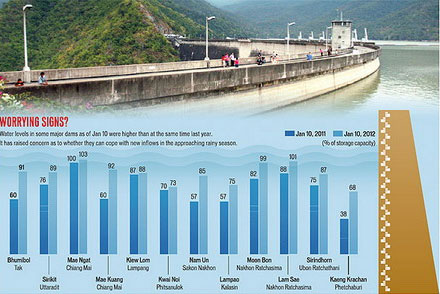Red alert on water dam
Thailand's water management and disaster prevention experts are "sitting idly", after postponing the release of water from dams and are likely to recur the horrifying flooding of last year.
In an interview with the Bangkok Post (Thailand) by phone, the President of the Thai National Disaster Warning Center, Mr. Smith Dharmasaroja, worries, the agencies in charge of operating the dams must remove the emergency water from the children. dam to ensure sufficient capacity for new water flow during the upcoming rainy season.
Mr. Smith said Thailand will experience a heavy rain this year due to the La Nina weather phenomenon.'We had to put up a plan to prepare water capacity in the key dams with water levels lower than the capacity of the dam 40%,' Mr. Smith said.
The Royal Thai Irrigation Department (RID) said on Jan. 10 that the Bhumibol dam is holding about 12, 3 billion cubic meters of water, equivalent to 90% of the dam's water storage capacity, while Sirikit dam has reached 89%. . Even more alarming is the ability to store water in most of the most important dams in the north, central and northeast, which is in excess of 70% of water storage capacity.

Red alert on water dam in Thailand. (Photo: Bangkok Post)
According to Mr. Smith, the Thai government needs to plan short-term flood prevention to prevent recurring flooding like in 2011.
Thai Minister of Science and Technology Plodprasop Suraswadi said that the water levels at Bhumibol and Sirikit dams are too high because only a few months are still until the rainy season.'I plan to inspect these dams to explain why they contain so much water,' said Mr. Suraswadi.
Two Bhumibol and Sirikit dams are located in Tak and Uttaradit provinces discharging from 40 to 55 million cubic meters of water each day to supply water for rice crops. Water levels in these dams will reach 40% at the end of the dry season (April).
Water flow at the dams is mostly much higher than in the same period last year, due to heavy rainfall and causing large volumes of water to flow into the dams."We are draining water from dams for agriculture purposes and creating space for new flows ," said Suraswadi.
- Yawning helps people become more alert
- When an accident occurred, how did the submarine alert?
- Netherlands launches emergency public alert system
- Fire cannons turn into vortex columns when touching the river
- WHO placed drug company Tamiflu on alert
- Cell phone help with flu, fever
- Alert Map - Real-time disaster warning
- Red alert of the risk of Southwestern forest fire in the United States
- 6 facts that make you change the way you think about using water
- Uses of the water tower
- Video: Warning device gives way to the fastest ambulance
- Intelligent salvage alert shark attack
 Is the magnetic North Pole shift dangerous to humanity?
Is the magnetic North Pole shift dangerous to humanity? Washington legalizes the recycling of human bodies into fertilizer
Washington legalizes the recycling of human bodies into fertilizer Lightning stone - the mysterious guest
Lightning stone - the mysterious guest Stunned by the mysterious sunset, strange appearance
Stunned by the mysterious sunset, strange appearance